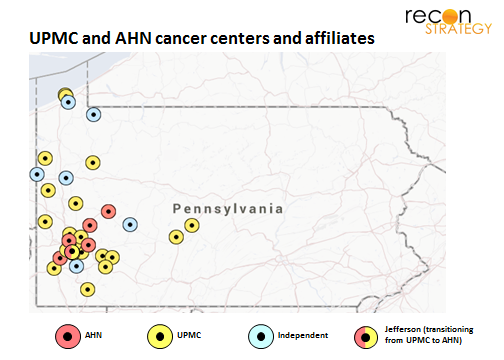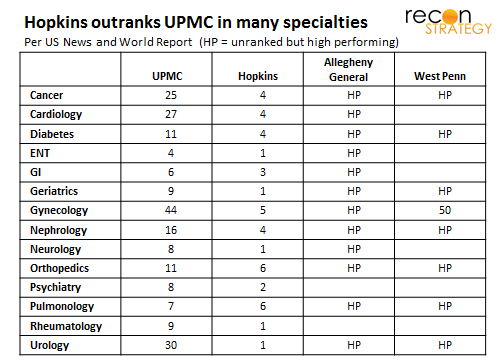Summary
- Allegheny Health Network (AHN), the major delivery system in Pittsburgh owned by Highmark, and Johns Hopkins Medicine have signed a MOU to create an affiliation between Allegheny and the Johns Hopkins Kimmel Cancer Center.
- Over many years, UPMC has established a very large network of cancer care throughout western Pennsylvania; AHN has responded in kind albeit much less broadly. At this point, there is very little independent cancer care left in the region.
- By partnering with a prominent UPMC competitor in oncology, the deal is likely designed to shore up the appeal of Highmark’s AHN-centered network among employers in the near-term and increase AHN’s appeal to high-profile physician recruits in the longer-term.
- Affiliation with the long-distance Johns Hopkins is another example of how strategic partnerships are trying to overcome geographic barriers between markets.
The government-mediated renewal of the Highmark-UPMC relationship (put in place in 2012) looks like it will expire at the end of 2014. Highmark has less than a year left to transform its AHN delivery system into a viable replacement to UPMC in its network. The recently announced alliance between AHN and the Johns Hopkins Kimmel Cancer Center signals part of how Highmark wants to establish itself as a credible competitor to UPMC.
Cancer care in western Pennsylvania
Cancer is a key competitive battlefield. A strong cancer network is no doubt a priority for accounts (especially in Pennsylvania which has the third-highest rate of cancer incidence in the US). And UPMC has long been dominant in cancer care in the region, for example:
- 74K cancer patients in 2013 vs. a total of 100K or so in the area
- A cancer research program boasting nearly $150M in funding and 334 ongoing oncology trials
- NCI designation and QOPI certification
- 180 affiliated oncologists (among them 103 medical oncologists and 37 radiation oncologists)
- Major cancer facilities in their own hospitals (prominently the Hillman Cancer Center at Shadyside but also Mercy, Passavant and St. Margaret)
- A network of joint ventures with independent hospitals and systems throughout Western PA (see map) including with Excela Health in 2002 (the Arnold Palmer Pavilion), with the Heritage Valley Beaver hospital in 2003, and with Butler Memorial hospital formed last year.
- #25 ranking for cancer in the country and #1 in Pennsylvania per US News and World Report
Highmark’s AHN also has a Cancer Institute with some key strengths:
- 35 medical oncologists and 13 radiation oncologists
- QOPI quality certification
- An accredited radiation oncology network
- A research program including 160+ ongoing clinical trials
However, AHN lacks both the cancer branding (their flagship hospital is unranked nationally in cancer care and only #14 in Pennsylvania) and scale of UPMC (AHN has ~10K oncology patients in the Pittsburgh area and its flagship hospital — Allegheny General — about 1/3 the cancer discharges vs. UPMC’s flagship). Further, much of UPMC’s share is “locked in” via those joint ventures. AHN has only a few oncology affiliations outside its own hospitals.
There are few meaningful “greenfield” oncology affiliation opportunities left in western PA. Most hospitals and oncologists are already in the UPMC or AHN “camps.” (Some rough estimates: Assuming there are roughly 250 to 270 oncologists in western Pennsylvania in proportion with population, only 50-70 are still independent. More important from a profitability perspective is the facilities-based care: UPMC sites –owned and through affiliated JVs– deliver about 70% and AHN facilities about 23% of that care, leaving just 7% in the unaffiliated sites). Without a stronger cancer capability, it is hard to see how AHN could win over systems with a UPMC affiliation to its own oncology care network.
Of course, AHN could affiliate at the hospital level (vs. the specialty level such as oncology) and try to replace UPMC in oncology top-down. AHN did this last year with two systems: Jefferson in Pittsburgh and St. Vincent in Erie, both of which had oncology JVs with UPMC (Jefferson since 2005 and St. Vincent since 2008). But the results are mixed: it appears that AHN has been able to start unwinding the Jefferson joint venture (staffing up with AHN affiliated oncologists) but the St. Vincent joint venture continues to be staffed only by UPMC doctors. And the strategy is expensive: the Jefferson deal involved a commitment of $175M in upgrades and foundation commitments while the St. Vincent deal involved $65M in investment – far too high a price tag per site for an oncology expansion strategy.
The Johns Hopkins alliance
The alliance with Hopkins should help AHN fill in some of these gaps. Hopkins has, for example, NCI designation for the Sidney Kimmel Cancer Center and #4 national ranking in cancer. The deal appears designed to make Johns Hopkins a long-distance partner to local doctors and supporting local care delivery rather than replacing or adding expertise locally for the direct provision of care. As part of the deal, AHN physicians will have access to:
- Over one thousand ongoing oncology clinical trials
- Physician-to-physician consultation services to AHN doctors
- Medical education opportunities
- Collaborating on joint initiatives to improve cancer care quality and safety
The play: near-term defensive with employers, long-term offensive with providers
This deal probably will not be meaningful to consumers since its key elements are physician related and fairly technical in their nature. The individual market is not, however, where Highmark is feeling the pain from UPMC’s departure (note: Highmark’s narrow-network Community Blue plans which exclude UPMC appears to be doing well on the Exchange, with Highmark earning 76% share in western Pennsylvania).
Instead, the deal is likely designed to help with larger group accounts. Highmark can now make the case that employers can avoid UPMC’s rates while still plausibly providing access to better oncology care for their employees. That argument may be most compelling to group accounts already with Highmark and looking for a good reason not to switch rather than winning new accounts. After all, the ink is hardly dry on the deal and there will be a lot of work to make it an operational reality. But, given Highmark’s high incumbent share, blocking competitor inroads into their book is a real win.
The deal should also help AHN gaining affiliation and referral partners in oncology, but only as part of a “long game”. The deal will make “offensive” recruiting of high profile specialists easier: AHN can now not only offer a lot of money (table stakes in the recruiting war between Highmark and UPMC) and access to a largest base of patients (Highmark still has the greatest share in the region) but also the opportunity to get plugged into the #4 cancer institution in the country. Over the next several years, expect increasing efforts by AHN to recruit UPMC oncologists and build out 2-way physician exchanges with Hopkins. Shifting the balance of AHN vs. UPMC as attractive cancer affiliation partners will take time. But the Hopkins deal lays some important groundwork. Key will be whether Highmark can hold on to its overwhelming member share (and, therefore oncology patients for the doctors to treat) over the next couple years to let this strategy play out.
A few speculations
Back in 2011, Highmark looked successfully for a major provider partner to affiliate with the entire West Penn Allegheny system before it was forced to take over the system itself. Both Cleveland Clinic and Johns Hopkins were in the consideration set. The Hopkins cancer deal suggests that Highmark has put aside the “big bang” partnership strategy with a nationally branded provider. Highmark may, instead, develop many condition-specific affiliations which are more feasible to close and offer the opportunity for a “best of breed” approach to selecting partners.
Johns Hopkins is entering the national market for cross-service area, condition-specific affiliations (what we like to call “CSA-CSA’s”) like their faster moving competitors Mayo, Cleveland Clinic, and MD Anderson. Our guess is this won’t be their last in cancer given their #4 ranking. And cancer won’t be the only specialty they explore this option. Hopkins has national ranking in all 15 of the major specialties covered by US News (including #1 in ENT, geriatrics, neurology, rheumatology, urology, #4 in cardiology and diabetes, #6 in orthopedics).
Interestingly, Hopkins outranks UPMC not just in cancer but also in many of these specialties. Perhaps Highmark is playing another “long game” with Hopkins, and, pending a successful launch of the cancer affiliation, plans to expand the same model to other specialties. At the end of the day, Highmark may still get its system-wide affiliation, but it will just get there through a series of specialty-specific steps.
This note was co-written by Shan Soe-Lin and Tory Wolff of Recon Strategy


